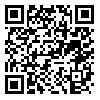Volume 8, Issue 4 (10-2020)
J. Pediatr. Rev 2020, 8(4): 275-282 |
Back to browse issues page
Download citation:
BibTeX | RIS | EndNote | Medlars | ProCite | Reference Manager | RefWorks
Send citation to:



BibTeX | RIS | EndNote | Medlars | ProCite | Reference Manager | RefWorks
Send citation to:
Dilek Aksoy S, Ozdilek R, Arzu Aba Y. Weaning Traditional Practices Among Mothers Coming to Primary Health Care Center in Turkey. J. Pediatr. Rev 2020; 8 (4) :275-282
URL: http://jpr.mazums.ac.ir/article-1-320-en.html
URL: http://jpr.mazums.ac.ir/article-1-320-en.html
1- Department of Midwifery, Health Science Faculty, Kocaeli University, Kocaeli, Turkey.
2- Department of Nursing, Health Science Faculty, Bandirma Onyedi Eylul University, Bandırma, Turkey. ,yildaarzum@hotmail.com
2- Department of Nursing, Health Science Faculty, Bandirma Onyedi Eylul University, Bandırma, Turkey. ,
Abstract: (5550 Views)
Background: The breastfeeding process is as vital for the mother as it is for the baby. Therefore, weaning is a difficult decision for both parties.
Objectives: This study aimed to determine the traditional and non-traditional methods that mothers use to wean their babies.
Methods: This descriptive type of study was conducted between May 15, 2018, and October 15, 2018, on 1124 women with healthy children aged 2-5 years who were referring to the Primary Health Care Center in Kocaeli Province in Turkey. The data were collected using a researcher-made questionnaire.
Results: Around 31.8% of mothers (n=358) applied a substance to their nipples, which is said to create a frightening effect for the baby. About 14.5% of mothers (n=164) applied substances on the nipple, to leave a bitter taste in the mouth of the baby, and reduce the desire to suck the nipple. Another method used to wean is to apply something that creates a repulsive effect on the nipple. This method was used by 12.3% of mothers (n=139). The percentage of women who failed on the first attempt was 11.38% (n=128). The reasons for re-starting breastfeeding were as follows: the method to wean was not working (21.1%, n=27), the influence of relatives to abandon weaning (6.2%; n=8), and the baby crying too much (89.1%; n=11).
Conclusions: Some mothers used the traditional method for weaning and the majority of the babies of the mothers who used the traditional method responded by crying. According to these findings, training and counseling on breastfeeding are recommended to mothers who are breastfeeding by nurses.
Objectives: This study aimed to determine the traditional and non-traditional methods that mothers use to wean their babies.
Methods: This descriptive type of study was conducted between May 15, 2018, and October 15, 2018, on 1124 women with healthy children aged 2-5 years who were referring to the Primary Health Care Center in Kocaeli Province in Turkey. The data were collected using a researcher-made questionnaire.
Results: Around 31.8% of mothers (n=358) applied a substance to their nipples, which is said to create a frightening effect for the baby. About 14.5% of mothers (n=164) applied substances on the nipple, to leave a bitter taste in the mouth of the baby, and reduce the desire to suck the nipple. Another method used to wean is to apply something that creates a repulsive effect on the nipple. This method was used by 12.3% of mothers (n=139). The percentage of women who failed on the first attempt was 11.38% (n=128). The reasons for re-starting breastfeeding were as follows: the method to wean was not working (21.1%, n=27), the influence of relatives to abandon weaning (6.2%; n=8), and the baby crying too much (89.1%; n=11).
Conclusions: Some mothers used the traditional method for weaning and the majority of the babies of the mothers who used the traditional method responded by crying. According to these findings, training and counseling on breastfeeding are recommended to mothers who are breastfeeding by nurses.
Type of Study: Original Article |
Subject:
Pediatrics
Received: 2020/04/28 | Accepted: 2020/06/27 | Published: 2012/10/1
Received: 2020/04/28 | Accepted: 2020/06/27 | Published: 2012/10/1
Send email to the article author
| Rights and permissions | |
 |
This work is licensed under a Creative Commons Attribution-NonCommercial 4.0 International License. |









